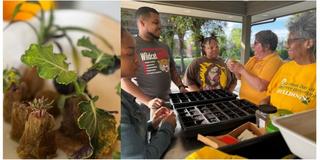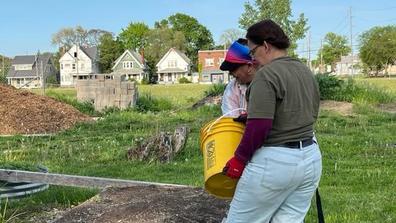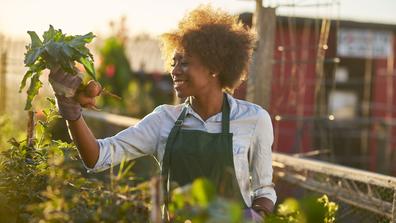Central State University student researchers lead African Heritage Crops Project

Above: Corey Higgs (foreground, left) was one of three Central State University students who planted a variety of African heritage crops in the Seed to Bloom Botanical and Community Garden under the guidance of Extension associate Clare Thorn (right, center). After harvesting the crops last fall, the team germinated seeds this spring, waiting for transplantation this summer.
Last summer, Kamille Austin, Mariah Simmons, and Corey Higgs, under the leadership of Clare Thorn, Central State University Extension associate for Agriculture and Natural Resources, researched nearly two dozen African heritage crops, including three varieties of okra, to test for growth sustainability and viability as marketable crops in the Midwest.
The crops included stripped toga eggplant, seven top turnips, green glaze collards, waterleaf, Mrihani basil, whippoorwill southern pea, iron and clay southern pea, Egusi melon, Hill Country okra, and nigella, and more.
USDA-funded agricultural research project
The Central State University team applied for and received a $49,999 grant from the U.S. Department of Agriculture's National Institute of Food and Agriculture to purchase more heritage crops, plant and grow them, and present their findings to diverse audiences during Black History Month in February. They presented at the Ohio Ecological Farm and Food Association (OEFFA) conference in Newark, Ohio, in February.
At the 45th annual OEFFA gathering, Thorn and the students presented on the Sustainability Agriculture Research and Education (SARE) project on African heritage crops, sponsored by the USDA-NIFA grant.
“Audience members were not only fascinated, but thrilled by the presentation topic as well as who was presenting it,” recalled Kamille Austin, a junior music major from Cincinnati.
“I am an African-American woman working in Extension. I am blessed to have such a culturally aware mentor, Ms. Clare Thorn, who refuses to overlook minorities. Under her tutelage, I was able to learn a lot about my cultural heritage, and so did the audience.”
“The audience was very moved by our presentation,” added Corey Higgs, a senior music major from the Bahamas. “They asked many questions and were curious to know if we would want to have a garden of our own.”
Simmons said, “After we presented our project, we received wonderful feedback. My overall experience was wonderful.”
Inspiration for the crop research project
Inspiration for the research project came after Thorn watched a PBS documentary on Percy Lavon Julian — a Black chemist from Montgomery, Alabama, whose pioneering work making a drug from the Calabar bean paved the way for glaucoma medicine. Connecting strongly with the PBS program, she wondered how many other African Americans like Julian were out there — who “created or invented something that improved agricultural practices” but remained undiscovered and uncelebrated.
“This led me to researching other African heritage crops to discover their impact on agriculture,” Thorn said. "I believed this knowledge would resonate with our students and encourage their engagement at the Seed to Bloom Botanical and Community Garden here at CSU. I felt bringing attention to African heritage crops was significant and that our students needed to understand their influence in our food system.”
The tragic history of the trans-Atlantic slave trade records that some of the crops traveled through the Middle Passage with captured African slaves, with women hiding seeds in their hair — at great personal peril — with hopes of preserving them in the New World.
“The first generation of Middle Passage survivors collectively accomplished something extraordinary,” wrote Judith A. Carney and Richard Nicholas Rosomoff in their book “In the Shadow of Slavery: Africa’s Botanical Legacy in the Atlantic World” (University of California Press). “They adopted the subsistence staples of Amerindians and instigated the cultivation of familiar African foods. With this fusion of crop traditions, they (Africans) confronted chronic hunger and diversified the often-monotonous diets imposed by slaveholders. In so doing, slaves Africanized the food systems of plantation societies of the Americas.”
Kamille Austin, Mariah Simmons, and Corey Higgs eagerly embraced the project of test-growing the crops in hopes of someday sharing stories of which crops among the group survived in Ohio’s climate.
Lessons learned
“For me as a criminal justice student, it was exciting for me to learn about my (African American) history, especially on the agriculture side,” said Simmons, a criminal justice junior from Detroit, Michigan.
Austin added that she was excited because she was going to learn more about her roots through agriculture, though something associated with the enslavement of Blacks in America.
“The idea of growing African crops at our HBCU speaks volumes of the amount of love and historical value they hold,” said Higgs.
“It paved the way for us to stay connected to our roots and the African diaspora that Miss Clare references often as the way the crops arrived in America.”
All three students agreed that planting, watering, and nurturing — work they did often with music playing in the garden — was soothing and helped to relieve some of the stress that comes with college life. For all three, harvesting what they had grown gave them unique joy and a sense of accomplishment.
If watching the African heritage crops grow to maturity was gratifying, preparing to educate an audience about them and eventually doing so was equally satisfying.
Noting that she and her friends spent about a month “planning for our presentation,” Austin said, “From my perspective, the highlights of the presentation included the history of agriculture and how it ties into African-American history. It humbled my heart understanding the roots of my race.”
Transformative experience
“This experience was transformative for us,” Simmons said. “Discussing the amazing Black figures who helped to inspire agriculture to be what it is today was truly inspirational.”
“The students grew daily in learning how to sow seeds, water, weed, and care for the crops,” Thorn said. “When it came to harvesting time, they were amazed to see how the work they put forth paid off with the produce we were able to donate to the Greene County Fish Pantry and the Second Harvest Food Bank of Clark, Champaign, and Logan Counties.”
“We were astonished at how many crops were produced and the number of seeds that could be collected, dried, and stored to test their viability in this year’s growing season,” Austin added. According to Thorn, they had enough seeds to distribute to those who attended their presentation at this year's OEFFA conference.
“I’ve learned through my experience that there’s so much that is held in a seed — a whole new world can be in just a seed,” Higgs said. “Especially considering how the seeds held the story of the African diaspora and their way of life.”
What's next for African Heritage Crops Project
All told, not all the African heritage crops survived Ohio’s uncertain climate during the first trial. The students will plant them again this summer and continue their research on how sustainable they can be in various parts of Ohio. The African American Urban Farmers group will also test the crops on two lots in Cincinnati and one in Columbus this summer.
The goal is that these crops will prove sustainable in the Ohio climate, and that farmers consider planting and marketing them to not only African Americans but to anyone desiring diverse, healthy, and nutritious food.
To learn more about the African Heritage Crop Project, email cthorn@centralstate.edu.


